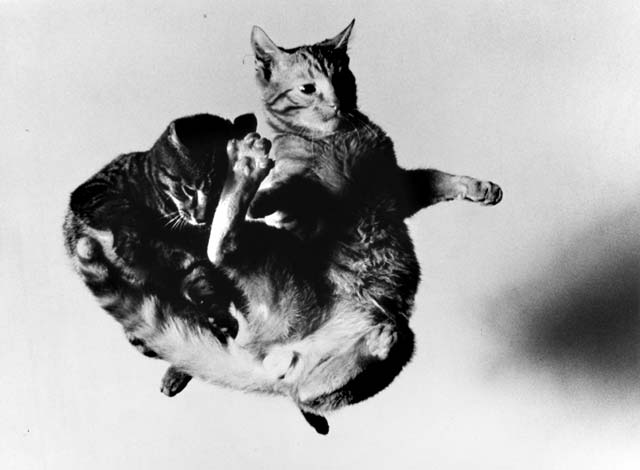‘We would be in a nasty position indeed if empirical science were the only kind of science possible.’ –Husserl
Look out into space and the signs are plain to see. The universe began in a Big Bang event some 13 billion years ago and has been expanding ever since. And the best evidence from the distance reaches of the cosmos is that this expansion is accelerating.
That has an important but unavoidable consequence: it means the universe will expand forever. And a universe that expands forever is infinite and eternal.
Today, a group of physicists rebel against this idea. They say an infinitely expanding universe cannot be so because the laws of physics do not work in an infinite cosmos. For these laws to make any sense, the universe must end, say Raphael Bousso at the University of California, Berkeley and few pals. And they have calculated when that is most likely to happen.
Their argument is deceptively simple and surprisingly powerful. Here’s how it goes. If the universe lasts forever, then any event that can happen, will happen, no matter how unlikely. In fact, this event will happen an infinite number of times.
This leads to a problem. When there are an infinite number of instances of every possible observation, it becomes impossible to determine the probabilities of any of these events occurring. And when that happens, the laws of physics simply don’t apply. They just break down. “This is known as the “measure problem” of eternal inflation,” say Bousso and buddies. (…)
When might his be? Bousso and co have crunched the numbers. “Time is unlikely to end in our lifetime, but there is a 50% chance that time will end within the next 3.7 billion years,” they say.
{ The Physics arXiv Blog | Continue reading }
This timeline of the Big Bang describes the history of the universe according to the prevailing scientific theory of how the universe came into being. (…) The best available measurements as of 2010 suggest that the initial conditions occurred between 13.3 and 13.9 billion years ago.
{ Wikipedia | Continue reading }
It may be possible to glimpse before the supposed beginning of time into the universe prior to the Big Bang, researchers now say.
Unfortunately, any such picture will always be fuzzy at best due to a kind of “cosmic forgetfulness.”
The Big Bang is often thought as the start of everything, including time, making any questions about what happened during it or beforehand nonsensical. Recently scientists have instead suggested the Big Bang might have just been the explosive beginning of the current era of the universe, hinting at a mysterious past.
The Chaotic Inflation theory is a variety of the inflationary universe model, which is itself an extension of the Big Bang theory. It was proposed by physicist Andrei Linde. (…)
The Chaotic Inflation theory is in some ways similar to Fred Hoyle’s Steady state theory, as it employs the metaphor of a universe that is eternally existing, and thus does not require a unique beginning or an ultimate end of the cosmos.
semantic bonus:

‘If you’re going to be crazy, you have to get paid for it or else you’re going to be locked up.’ –Hunter S. Thompson

Okay, we’ll be starting in a few moments… just waiting for the drugs to take effect. (…) I mentioned that, earlier in the show, a drug joke - and I hate to do that, because it creates a mess, and I’m not into drugs any more. I quit completely, and I hate people who are still into it.
{ Steve Martin’s Monologue | Saturday Night Live Transcript | Continue reading }
photo { Bruce Davidson, Coney Island, 1959 }
‘For to win one hundred victories in one hundred battles is not the acme of skill. To subdue the enemy without fighting is the acme of skill.’ –Sun Tzu
In thinking about Afghanistan, it is essential that we begin by thinking about the nature of guerrilla warfare against an occupying force. The guerrilla lives in the country. He isn’t going anywhere else, as he has nowhere to go. By contrast, the foreigner has a place to which he can return. This is the core weakness of the occupier and the strength of the guerrilla. The former can leave and in all likelihood, his nation will survive. The guerrilla can’t. And having alternatives undermines the foreigner’s will to fight regardless of the importance of the war to him.
The strategy of the guerrilla is to make the option to withdraw more attractive. In order to do this, his strategic goal is simply to survive and fight on whatever level he can. His patience is built into who he is and what he is fighting for. The occupier’s patience is calculated against the cost of the occupation and its opportunity costs, thus, while troops are committed in this country, what is happening elsewhere?
Tactically, the guerrilla survives by being elusive. He disperses in small groups. He operates in hostile terrain. He denies the enemy intelligence on his location and capabilities. He forms political alliances with civilians who provide him supplies and intelligence on the occupation forces and misleads the occupiers about his own location. The guerrilla uses this intelligence network to decline combat on the enemy’s terms and to strike the enemy when he is least prepared. The guerrilla’s goal is not to seize and hold ground but to survive, evade and strike, imposing casualties on the occupier. Above all, the guerrilla must never form a center of gravity that, if struck, would lead to his defeat. He thus actively avoids anything that could be construed as a decisive contact. (…)
The asymmetry of this warfare favors the guerrilla. This is particularly true when the strategic value of the war to the occupier is ambiguous, where the occupier does not possess sufficient force and patience to systematically overwhelm the guerrillas, and where either political or military constraints prevent operations against sanctuaries.
Witnessing a horse being whipped by a coachman at the Piazza Carlo Alberto, Nietzsche threw his arms around the horse’s neck and collapsed

Horses have become so devalued in Dublin they have been swapped for a mobile phone or purchased for as little as €15, an Oireachtas committee was told yesterday.
The Committee on Agriculture, Fisheries and Food was also told welfare problems in the capital included animals being starved, ridden to exhaustion, beaten, slashed, rammed by cars and set alight.
Dublin City Council deputy city manager Philip Maguire said there were only 30 licensed horses in Dublin, mainly carriage horses, but there were hundreds of unidentified horses in the city.
Ain’t no room 4 disagreein, uh? 1+1+1 is 3

Singapore math is taking hold in schools throughout the country. Here in New York City, home to the nation’s largest school system, a small but growing number of schools have adopted this approach, based on Singapore’s national math system.
Many teachers and parents here say Singapore math helps children develop a deeper understanding of numbers and math concepts than they gain through other math programs.
artwork { Jasper Johns, 0 through 9, 1960 }
Like a carousel that’s turning running rings around the moon

{ Empire State’s October lighting | Illustration: Chris Ware }
related { New Yorkers outraged as bureaucrats order city to change lettering on every single street sign }
‘All sing: I rose up one maypole morning and saw in my glass how nobody loves me but you. Ugh. Ugh.’ –James Joyce
Psychologists tend to take the experience of regret as a given, and occupy themselves with the study of its antecedents, consequences, and boundary conditions. They find, for example, that short-term regret is focused on things we did rather than did not do, whereas long-term regret shows the reverse pattern. (…)
Regret springs from the wish to undo an earlier decision. Why? Typically, we feel regret when-and because-we have obtained new information.
Y’say one for the trouble, two for the time, come on girls let’s rock that

{ Urban legend has it that the hemline is correlated with the economy. In times of decline, the hemline moves towards the floor (decreases), and when the economy is booming, skirts get shorter and the hemline increases. | via Barry Ritholtz | Continue reading }
photo { Arseni Khamzin }
‘Given the same amount of intelligence, timidity will do a thousand times more damage than audacity’ –Clausewitz
Ideas are works of bricolage. They are, almost inevitably, networks of other ideas. We take the ideas we’ve inherited or stumbled across, and we jigger them together into some new shape. (…)
Evolution advances by taking available resources and cobbling them together to create new uses. The evolutionary theorist Francois Jacob captured this in his concept of evolution as a “tinkerer,” not an engineer; our bodies are also works of bricolage, old parts strung together to form something radically new. (…)
You can see this process at work in the primordial innovation of life itself. Before life emerged on Earth, the planet was dominated by a handful of basic molecules: ammonia, methane, water, carbon dioxide, a smattering of amino acids and other simple organic compounds. Each of these molecules was capable of a finite series of transformations and exchanges with other molecules in the primordial soup: methane and oxygen recombining to form formaldehyde and water, for instance.
Think of all those initial molecules, and then imagine all the potential new combinations that they could form spontaneously, simply by colliding with each other (or perhaps prodded along by the extra energy of a propitious lightning strike).
A time of freedom, a time of feeling that maybe choices are open to you

We are used to thinking of culture as a social factor and not a biological factor. We attribute dispositions such as being individualistic or being collectivist to the country that one was brought up in, but no one has really looked into why certain cultures tend to be that way. An emerging field of research called cultural neuroscience says that cultural values can be shaped by the brain and genes.
For example, in one striking example I read about quite recently, one hypothesis put forth for the reason why Asian people like spicy food was because spices conferred natural bacteria killing properties that was especially important in a humid climate where food went bad. Over time, the hypothesis goes, people who liked spicy food more and ate more spicy food were less prone to stomach diseases that killed the others, thus passing on their genes for the next generation. A similar finding was found when examining lactose intolerance. Lactose intolerance is far more prevalent in certain regions of Asia where the rearing of lifestock for milk is less common. In Europe however, up to 95% are able to digest lactose, and this is reflected in their preference for milk products like cream and cheese.
related { Chillies burn our tongues, make our eyes water and bring us out in a sweat. A developmental psychologist looks at a peculiarly human form of masochism | The Guardian | full story }
photo { Molly Schiot }
The Committee will continue to monitor the economic outlook and financial developments

It has always been tough for literary fiction writers to get their work published by the top publishing houses. But the digital revolution that is disrupting the economic model of the book industry is having an outsize impact on the careers of literary writers.
Priced much lower than hardcovers, many e-books generate less income for publishers. And big retailers are buying fewer titles. As a result, the publishers who nurtured generations of America’s top literary-fiction writers are approving fewer book deals and signing fewer new writers. Most of those getting published are receiving smaller advances.
“Advances are down, and there aren’t as many debuts as before,” says Ira Silverberg, a well-known literary agent. “We’re all trying to figure out what the business is as it goes through this digital disruption.”
Much as cheap digital-music downloads have meant that fewer bands can earn a living from record-company deals, fewer literary authors will be able to support themselves as e-books win acceptance, publishers and agents say.
photo { Tim Geoghegan }
previously { Seth Godin: The new dynamics of book publishing }
From the top of it all life itself seems a whole mistake
Ben Bernanke has not only refused to abandon his idee fixe of an “inflation target”, a key cause of the global central banking catastrophe of the last twenty years (because it can and did allow asset booms to run amok, and let credit levels reach dangerous extremes).
Worse still, he seems determined to print trillions of emergency stimulus without commensurate emergency justification to test his Princeton theories, which by the way are as old as the hills. Keynes ridiculed the “tyranny of the general price level” in the early 1930s, and quite rightly so. Bernanke is reviving a doctrine that was already shown to be bunk eighty years ago.
{ Telegraph | Continue reading }
Structural unemployment is a fake problem, which mainly serves as an excuse for not pursuing real solutions.
Who are these wise heads I’m talking about? The most widely quoted figure is Narayana Kocherlakota, the president of the Federal Reserve Bank of Minneapolis, who has attracted a lot of attention by insisting that dealing with high unemployment isn’t a Fed responsibility: “Firms have jobs, but can’t find appropriate workers. The workers want to work, but can’t find appropriate jobs,” he asserts, concluding that “It is hard to see how the Fed can do much to cure this problem.”
Now, the Minneapolis Fed is known for its conservative outlook, and claims that unemployment is mainly structural do tend to come from the right of the political spectrum. But some people on the other side of the aisle say similar things. For example, former President Bill Clinton recently told an interviewer that unemployment remained high because “people don’t have the job skills for the jobs that are open.”
Well, I’d respectfully suggest that Mr. Clinton talk to researchers at the Roosevelt Institute and the Economic Policy Institute, both of which have recently released important reports completely debunking claims of a surge in structural unemployment.
After all, what should we be seeing if statements like those of Mr. Kocherlakota or Mr. Clinton were true? The answer is, there should be significant labor shortages somewhere in America — major industries that are trying to expand but are having trouble hiring, major classes of workers who find their skills in great demand, major parts of the country with low unemployment even as the rest of the nation suffers.
None of these things exist. Job openings have plunged in every major sector, while the number of workers forced into part-time employment in almost all industries has soared. Unemployment has surged in every major occupational category. Only three states, with a combined population not much larger than that of Brooklyn, have unemployment rates below 5 percent.
Oh, and where are these firms that “can’t find appropriate workers”? The National Federation of Independent Business has been surveying small businesses for many years, asking them to name their most important problem; the percentage citing problems with labor quality is now at an all-time low, reflecting the reality that these days even highly skilled workers are desperate for employment.
So all the evidence contradicts the claim that we’re mainly suffering from structural unemployment. Why, then, has this claim become so popular?
Part of the answer is that this is what always happens during periods of high unemployment — in part because pundits and analysts believe that declaring the problem deeply rooted, with no easy answers, makes them sound serious.
‘Shall I then seek my lost ones; with another love shall I then love you.’ –Nietzsche
Some people are surprised, even disturbed, by the idea that our vision does not give us an accurate picture of what we look at. For example, the colours we experience are not a measure of the wavelength of the light entering our eyes. But accuracy is not the point of vision; the function is to be useful and colour consistency is far more useful then fidelity to wavelength spectra. The same surprise is shown in the reaction to the idea that our memories are reworked continuously so that over time they lose their accuracy. (…)
A great deal of biological energy is used to create memories and to re-consolidate them and therefore we can assume that they have a very important biological role. (…)
We first have to have the experiences to remember – we create consciousness experiences which become stored as temporary memories. These are soon made more permanent as an event or an episode. Over weeks, months, years, decades they are continually reworked and re-consolidated. They are packaged together and lose their individuality, they are up-dated by newer memories, they are categorized and lose detail not related to their category. Eventually they lose their character as episodic memory and became more a factual or semantic type of memory.
From coast to coast so you stop being like a comatose

In a recent fMRI study, researchers showed that Cantonese verbs and nouns are processed in (slightly) different parts of the brain than English nouns and verbs in bilinguals. (…)
Chinese nouns and verbs showed a largely overlapping pattern of cortical activity. In contrast, English verbs activated more brain regions compared to English nouns. Specifically, the processing of English verbs evoked stronger activities of left putamen, left fusiform gyrus, cerebellum, right cuneus, right middle occipital areas, and supplementary motor area. The cognition of English nouns did not evoke stronger activities in any cortical regions.
This is truly language affecting thought, no? The point of general interest to linguist is that bilingual speakers seem to process words in their two languages differently. Cantonese words are processed using diffuse brain regions and English words are processed using localized regions (this is a simplified explanation of course).
painting { Miriam Cabessa, Little Black 2, 2008 | oil on linen }
Full of a strange shining, hung enraptured on her sweet flowerlike face

Consider the orange. Citrus sinensis. Its fleshy, segmented fruit has a tight-fitting skin and contains at least 300 different chemicals. It is not easy to grow. It takes about 13 gallons of water. The fruit only ripens on the tree before it’s picked. And since they’re only grown in six states, oranges are either packed and shipped to places where citrus doesn’t grow or processed into one of America’s favorite breakfast drinks: orange juice. (…)
Lahousse charted the 10 key components of an orange in a sunburst diagram. Each color stands for a key flavor component and using the right combination of other ingredients, one could create the taste of an orange without actually using an orange.
artwork { Mark Rothko, Orange and Yellow, 1956 }
‘Women keep a special corner of their hearts for sins they have never committed.’ –Cornelia Otis Skinner

Real misogyny happens every day. The fabric of modern life is sodden with sexism, crusted with a debris of institutional discrimination that looks, from a distance, like part of the pattern. (…) They make sexual comments about women in the street.
photo { Garry Winogrand | New York, 1968 }
‘Compassion for animals is intimately connected with goodness of character, and it may be confidently asserted that he who is cruel to animals cannot be a good man.’ –Schopenhauer

Babies can readily differentiate pet dogs and cats from “life-like” battery-operated toy dogs and cats. Babies will smile at, hold, follow, and make sounds in response to the live animals more than in response to the toys. In one study, 9 month olds were more interested in a live rabbit than an adult female stranger or a wooden turtle. A 1989 study of 2- to 6-year-olds with animals in their classrooms showed that children ignored realistic stuffed animals (80% never looked at them), but that live animals - especially dogs and birds - captured the attention of the children. Seventy-four percent touched the dog, 21% kissed the dog, and more than 66% talked to the bird.
Living with pets seems to stimulate children’s learning about basic biology. In one study, Japanese researchers showed that kindergarteners who had cared for pet goldfish better understood unobservable biological traits of their goldfish, and gave more accurate answers to questions like “does a goldfish have a heart?” (…)
When asked to name the 10 most important individuals in their lives, 7- and 10-year-olds on average included 2 pets.











